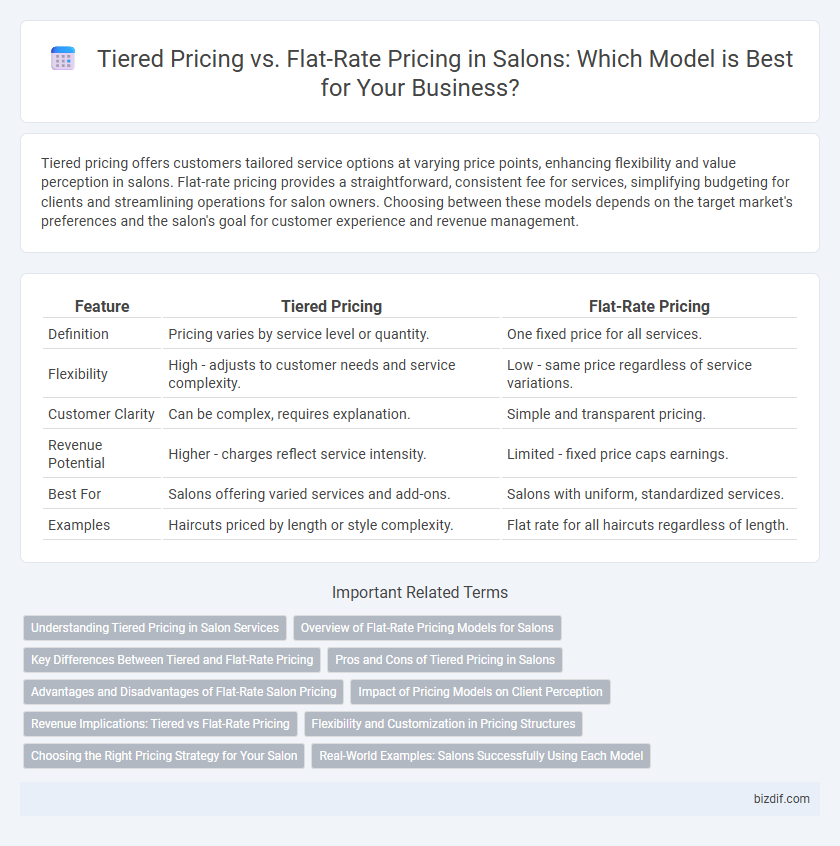Tiered pricing offers customers tailored service options at varying price points, enhancing flexibility and value perception in salons. Flat-rate pricing provides a straightforward, consistent fee for services, simplifying budgeting for clients and streamlining operations for salon owners. Choosing between these models depends on the target market's preferences and the salon's goal for customer experience and revenue management.
Table of Comparison
| Feature | Tiered Pricing | Flat-Rate Pricing |
|---|---|---|
| Definition | Pricing varies by service level or quantity. | One fixed price for all services. |
| Flexibility | High - adjusts to customer needs and service complexity. | Low - same price regardless of service variations. |
| Customer Clarity | Can be complex, requires explanation. | Simple and transparent pricing. |
| Revenue Potential | Higher - charges reflect service intensity. | Limited - fixed price caps earnings. |
| Best For | Salons offering varied services and add-ons. | Salons with uniform, standardized services. |
| Examples | Haircuts priced by length or style complexity. | Flat rate for all haircuts regardless of length. |
Understanding Tiered Pricing in Salon Services
Tiered pricing in salon services allows clients to choose from multiple service levels, such as basic, premium, and deluxe packages, each with varying features and prices. This pricing model helps salons cater to diverse customer needs and budgets while maximizing revenue through upselling opportunities. Understanding tiered pricing enables salons to clearly communicate service benefits and encourages customers to select options that best suit their preferences.
Overview of Flat-Rate Pricing Models for Salons
Flat-rate pricing models in salons establish a single, fixed charge for specific services regardless of time or product variations, simplifying customer expectations and billing processes. This pricing strategy is often used for standard services such as haircuts, coloring, or styling, providing transparency and consistency in cost. Salons benefit from flat-rate pricing by streamlining operations and enhancing client trust through predictable pricing.
Key Differences Between Tiered and Flat-Rate Pricing
Tiered pricing in salons charges clients based on variable service levels or product quantities, creating customized payment options that reflect usage or selection differences. Flat-rate pricing offers a fixed fee regardless of service complexity or duration, providing straightforward, predictable costs for customers. This key difference affects client experience, with tiered pricing promoting flexibility and flat-rate pricing emphasizing simplicity and transparency.
Pros and Cons of Tiered Pricing in Salons
Tiered pricing in salons offers flexibility by allowing clients to choose services based on skill level or service complexity, increasing customer satisfaction and revenue potential. It incentivizes stylists to develop advanced skills and helps salons manage labor costs more effectively by aligning prices with expertise. However, tiered pricing can confuse customers unfamiliar with the structure and may lead to dissatisfaction if expectations of service quality are not clearly communicated.
Advantages and Disadvantages of Flat-Rate Salon Pricing
Flat-rate salon pricing offers clients predictable costs for services, enhancing budget transparency and simplifying billing processes for both customers and staff. This pricing model can attract budget-conscious clients and streamline service packages but may limit flexibility in accommodating individualized treatments or varying service times. However, flat-rate pricing risks undercharging for more complex services and overcharging for simpler ones, potentially impacting profitability and customer satisfaction.
Impact of Pricing Models on Client Perception
Tiered pricing in salons allows clients to choose services based on specific needs and budgets, enhancing perceived value and customization. Flat-rate pricing offers simplicity and predictability, attracting clients seeking straightforward options without hidden fees. Client perception shifts as tiered models emphasize flexibility and personalized care, while flat rates convey consistency and transparency.
Revenue Implications: Tiered vs Flat-Rate Pricing
Tiered pricing in salons increases revenue by catering to diverse customer needs with multiple service levels, encouraging upselling and higher average transaction values. Flat-rate pricing simplifies billing but may limit profitability by attracting price-sensitive clients and capping revenue potential per service. Salons adopting tiered pricing can better segment the market, optimize customer lifetime value, and drive incremental income through customized offerings.
Flexibility and Customization in Pricing Structures
Tiered pricing offers enhanced flexibility by allowing salons to tailor service packages based on client needs and usage frequency, promoting customized customer experiences. Flat-rate pricing simplifies billing with a single fixed price, but may lack the adaptability to accommodate varying service levels or client demands. Salons leveraging tiered pricing can optimize revenue by aligning prices with specific service tiers, enhancing client satisfaction through personalized options.
Choosing the Right Pricing Strategy for Your Salon
Selecting the right pricing strategy for your salon involves understanding the benefits of tiered pricing and flat-rate pricing models. Tiered pricing offers clients customized service levels and price points, enhancing customer satisfaction and maximizing revenue from varied service demands. Flat-rate pricing simplifies billing with consistent charges, appealing to clients seeking straightforward, predictable costs and streamlining salon operations for efficiency.
Real-World Examples: Salons Successfully Using Each Model
Salons like Drybar have thrived using tiered pricing, offering varied service packages based on hair length and style complexity, effectively capturing different customer segments. On the other hand, popular chains such as Supercuts utilize flat-rate pricing, providing a consistent, transparent cost for standard haircuts that appeals to budget-conscious clients. Both models demonstrate success by aligning pricing strategies with customer expectations and service offerings in competitive salon markets.
Tiered Pricing vs Flat-Rate Pricing Infographic

 bizdif.com
bizdif.com